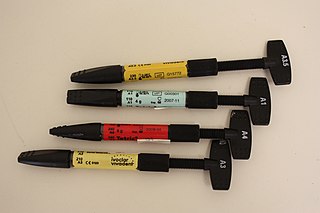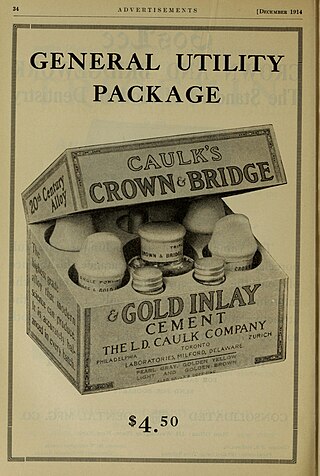Dental products are specially fabricated materials, designed for use in dentistry. There are many different types of dental products, and their characteristics vary according to their intended purpose.
Dental restoration, dental fillings, or simply fillings are treatments used to restore the function, integrity, and morphology of missing tooth structure resulting from caries or external trauma as well as to the replacement of such structure supported by dental implants. They are of two broad types—direct and indirect—and are further classified by location and size. Root canal therapy, for example, is a restorative technique used to fill the space where the dental pulp normally resides and are more hectic than a normal filling.
Dental sealants are a dental treatment intended to prevent tooth decay. Teeth have recesses on their biting surfaces; the back teeth have fissures (grooves) and some front teeth have cingulum pits. It is these pits and fissures that are most vulnerable to tooth decay because food and bacteria stick in them and because they are hard-to-clean areas. Dental sealants are materials placed in these pits and fissures to fill them in, creating a smooth surface which is easy to clean. Dental sealants are mainly used in children who are at higher risk of tooth decay, and are usually placed as soon as the adult molar teeth come through.

In dentistry, a crown or a dental cap is a type of dental restoration that completely caps or encircles a tooth or dental implant. A crown may be needed when a large dental cavity threatens the health of a tooth. Some dentists will also finish root canal treatment by covering the exposed tooth with a crown. A crown is typically bonded to the tooth by dental cement. They can be made from various materials, which are usually fabricated using indirect methods. Crowns are used to improve the strength or appearance of teeth and to halt deterioration. While beneficial to dental health, the procedure and materials can be costly.

Dental composite resins are dental cements made of synthetic resins. Synthetic resins evolved as restorative materials since they were insoluble, of good tooth-like appearance, insensitive to dehydration, easy to manipulate and inexpensive. Composite resins are most commonly composed of Bis-GMA and other dimethacrylate monomers, a filler material such as silica and in most applications, a photoinitiator. Dimethylglyoxime is also commonly added to achieve certain physical properties such as flow-ability. Further tailoring of physical properties is achieved by formulating unique concentrations of each constituent.

Abrasion is the non-carious, mechanical wear of tooth from interaction with objects other than tooth-tooth contact. It most commonly affects the premolars and canines, usually along the cervical margins. Based on clinical surveys, studies have shown that abrasion is the most common but not the sole aetiological factor for development of non-carious cervical lesions (NCCL) and is most frequently caused by incorrect toothbrushing technique.

In dentistry, inlays and onlays are used to fill cavities, and then cemented in place in the tooth. This is an alternative to a direct restoration, made out of composite, amalgam or glass ionomer, that is built up within the mouth.

A temporary crown is a temporary (short-term) crown used in dentistry. Like other interim restorations, it serves until a final (definitive) restoration can be inserted. Usually the temporary crown is constructed from acrylic resins (monomethacrylate-based/polymethacrylate-based) or, chemical-cure/light cure composite (dimethacrylate-based), although alternative systems using aluminium crown forms are occasionally used. Temporary crowns function to protect the tooth, prevent teeth shifting, provide cosmetics, shape the gum tissue properly, and prevent sensitivity.

A glass ionomer cement (GIC) is a dental restorative material used in dentistry as a filling material and luting cement, including for orthodontic bracket attachment. Glass-ionomer cements are based on the reaction of silicate glass-powder and polyacrylic acid, an ionomer. Occasionally water is used instead of an acid, altering the properties of the material and its uses. This reaction produces a powdered cement of glass particles surrounded by matrix of fluoride elements and is known chemically as glass polyalkenoate. There are other forms of similar reactions which can take place, for example, when using an aqueous solution of acrylic/itaconic copolymer with tartaric acid, this results in a glass-ionomer in liquid form. An aqueous solution of maleic acid polymer or maleic/acrylic copolymer with tartaric acid can also be used to form a glass-ionomer in liquid form. Tartaric acid plays a significant part in controlling the setting characteristics of the material. Glass-ionomer based hybrids incorporate another dental material, for example resin-modified glass ionomer cements (RMGIC) and compomers.

A luting agent is a dental cement connecting the underlying tooth structure to a fixed prosthesis. To lute means to glue two different structures together. There are two major purposes of luting agents in dentistry – to secure a cast restoration in fixed prosthodontics, and to keep orthodontic bands and appliances in situ.

In dentistry, amalgam is an alloy of mercury used to fill teeth cavities. It is made by mixing a combination of liquid mercury and particles of solid metals such as silver, copper or tin. The amalgam is mixed by the dentist just before use. It remains soft for a short while after mixing, which facilitates it being snugly packed into the cavity and shaped before it sets hard.
Restorative dentistry is the study, diagnosis and integrated management of diseases of the teeth and their supporting structures and the rehabilitation of the dentition to functional and aesthetic requirements of the individual. Restorative dentistry encompasses the dental specialties of endodontics, periodontics and prosthodontics and its foundation is based upon how these interact in cases requiring multifaceted care. This may require the close input from other dental specialties such as orthodontics, paediatric dentistry and special care dentistry, as well as surgical specialties such as oral and maxillofacial surgery.
A resin-retained bridge is a bridge replacing a missing tooth that relies for its retention on a composite resin cement. It is one of many available dental restoration methods which is considered minimally invasive and conservative of tooth tissue. The resin-retained-bridge has gone through a number of iterations. Perhaps the best known is the Maryland bridge and other designs used in the past include the Rochette bridge. The five-year survival rate is around 83.6% and the ten-year rate at 64.9%. The case selection is important and as with any dental prosthesis, good oral hygiene is paramount for success. In recent years, the indications for the use of resin-retained-bridges have diminished significantly and there have been changes in the principles underpinning their design. Resin-retained-bridges should be considered when a fixed prosthesis retained by natural teeth is required. The use has been driven by the advent of evidence-based dentistry showing the benefits to patients of reduced tooth preparation and the importance of an intact enamel structure for the long-term health of the teeth. The bridge is currently in favour in the United Kingdom for these reasons. Indeed, recent contemporary research shows resin retained bridges have better success rates than implants and are a cheaper alternative.
Dental cements have a wide range of dental and orthodontic applications. Common uses include temporary restoration of teeth, cavity linings to provide pulpal protection, sedation or insulation and cementing fixed prosthodontic appliances. Recent uses of dental cement also include two-photon calcium imaging of neuronal activity in brains of animal models in basic experimental neuroscience.
Mineral trioxide aggregate (MTA) is an alkaline, cementitious dental repair material. MTA is used for creating apical plugs during apexification, repairing root perforations during root canal therapy, and treating internal root resorption. It can be used for root-end filling material and as pulp capping material. It has better pulpotomy outcomes than calcium hydroxide or formocresol, and may be the best known material, as of 2018 data. For pulp capping, it has a success rate higher than calcium hydroxide, and indistinguishable from Biodentin.
Minimal intervention (MI) dentistry is a modern dental practice designed around the principal aim of preservation of as much of the natural tooth structure as possible. It uses a disease-centric philosophy that directs attention to first control and management of the disease that causes tooth decay—dental caries—and then to relief of the residual symptoms it has left behind—the decayed teeth. The approach uses similar principles for prevention of future caries, and is intended to be a complete management solution for tooth decay.

Pulp capping is a technique used in dental restorations to protect the dental pulp, after it has been exposed, or nearly exposed during a cavity preparation, from a traumatic injury, or by a deep cavity that reaches the center of the tooth, causing the pulp to die. Exposure of the pulp causes pulpitis. The ultimate goal of pulp capping or stepwise caries removal is to protect a healthy dental pulp, and avoid the need for root canal therapy.
Pediatric crowns are dental crowns that provide full coverage for primary teeth. They can be made of different materials including stainless steel, polycarbonate, zirconium, or composite resin.
Dental cermets, or silver cermets, are a type of restorative material dentists use to fill tooth cavities.
Atraumatic restorative treatment (ART) is a method for cleaning out tooth decay from teeth using only hand instruments and placing a filling. It does not use rotary dental instruments to prepare the tooth and can be performed in settings with no access to dental equipment. No drilling or local anaesthetic injections are required. ART is considered a conservative approach, not only because it removes the decayed tissue with hand instruments, avoiding removing more tissue than necessary which preserves as much tooth structure as possible, but also because it avoids pulp irritation and minimises patient discomfort. ART can be used for small, medium and deep cavities caused by dental caries.









